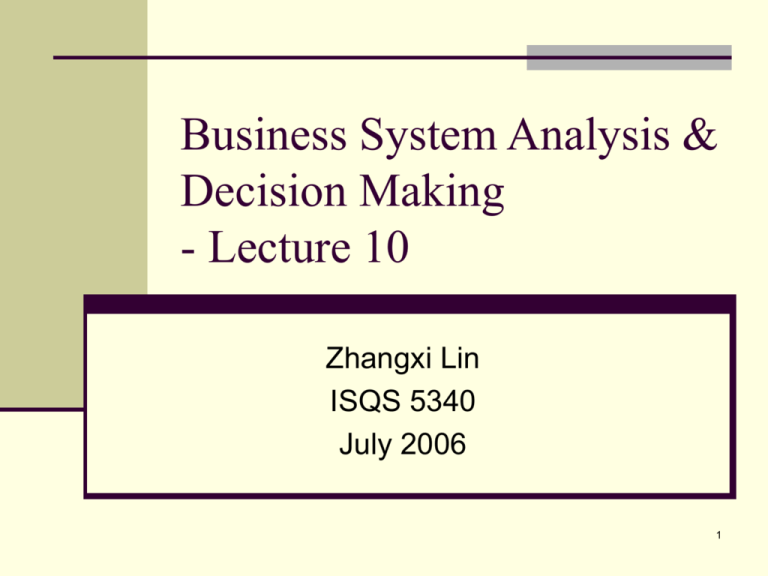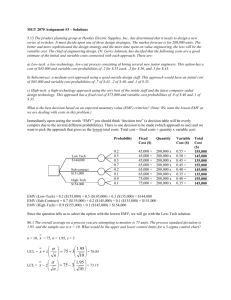Business System Analysis & Decision Making
advertisement

Business System Analysis & Decision Making - Lecture 10 Zhangxi Lin ISQS 5340 July 2006 1 Modeling Uncertainty Probability Review Using Data Histograms Descriptive Statistics Regression Value of Information Conditional Probability and Bayes’ Theorem Expected Value of Perfect Information Expected Value of Imperfect Information 2 Probability Review P(A|B) = P(A and B) / P(B) “Probability of A given B” Example, there are 40 female students in a class of 100. 10 of them are from some foreign countries. 20 male students are also foreign students. Even A: student from a foreign country Even B: a female student If randomly choosing a female student to present in the class, the probability she is a foreign student: P(A|B) = 10 / 40 = 0.25, or P(A|B) = P (A & B) / P (B) = (10 /100) / (40 / 100) = 0.1 / 0.4 = 0.25 That is, P(A|B) = # of A&B / # of B = (# of A&B / Total) / (# of B / Total) = P(A & B) / P(B) 3 Venn Diagrams 30+10 = 40 Female (30) Male non-foreign student (40) 20+10 = 30 Foreign (10) Student (20) Female foreign student (10) 4 Probability Review Complement P( A ) 1 P( A) P( B ) 1 P( B) Non Female Female Non Foreign Student Foreign student 5 Bayes’ Theorem P( A & B) P( A | B) P( B) P( A & B) P( B) P( A & B) P( B | A) P( B | A) P( A) P( A & B) P( A) P( A | B) So: P( A | B) P( B) P( B | A) P( A) P( B | A) P( A | B) P( B) P( A | B) P( B) P( A) P( A | B) P( B) P( A | B ) P( B ) The above formula is referred to as Bayes’ theorem. It is extremely Useful in decision analysis when using information. 6 Using Data We have addressed briefly behavioral judgments and theoretical probability issues under certainty and uncertainty. We now consider how to use data to conduct our decision analysis. Why need data? No data no decision. Think about why search engine is so hot. How to make data useful IT helps us to cope with information explosion Models and methods are important to guide us how to analyze data. 7 Histograms Bin Math Video <=2 4 0 3-5 6 1 6-8 9 10 >8 3 11 The histogram is based on the survey data From the ISQS 5340 class 12 10 The scale: 1-10 indicating Strong negative to strong positive response to the survey questions. 8 Math 6 Video 4 2 0 <=2 3-5 6-8 >8 8 Descriptive Statistics Math Mean Video Note 5.59091 8.59091 6 8.5 Standard Deviation 2.61241 1.46902 Dev = V0.5 Sample Variance 6.82468 2.15801 V = (x- mean)2 / # of obs Range 9 5 Minimum 1 5 Maximum 10 10 123 189 22 22 Median Sum Count The average of the data 9 The Relationship between Data Math-Video 12 8 6 4 Math-Video 2 Linear (Math-Video) 0 0 2 4 6 8 10 12 Math Chart Title 12 10 8 Video Video 10 6 4 2 Case-Video 0 0 2 4 6 8 Linear (Case-Video) 10 12 Case 10 Regression Y = a + b*X Example: Video_point = a + b*Math_point 11 Regression: Math - Video Regression Statistics R Square Standard Error Observations 0.0248 1.487 22 Coefficie nts Intercept X Variable 1 Standard Error t Stat P-value Lower 95% Upper 95% Lower 95.0% Upper 95.0% 9.086 0.7632 11.905 1.56E10 7.494 10.678 7.494 10.678 -0.0885 0.1242 -0.713 0.4843 -0.3475 0.1705 -0.348 0.1705 12 Regression: Case - Video Regression Statistics R Square 0.227 Standard Error 1.323 Observations 22 Coefficie nts Standard Error t Stat Pvalue Lower 95% Upper 95% Lower 95.0% Upper 95.0% Intercept 6.623 0.859 7.708 2E-07 4.83 8.415 4.83 8.415 X Variable 1 0.297 0.122 2.425 0.025 0.042 0.552 0.042 0.552 13 Value of Information When facing uncertain prospects we need information in order to reduce uncertainty Information gathering includes consulting experts, conducting surveys, performing mathematical or statistical analyses, etc. 14 Expected Value of Perfect Information (EVPI) Revisit the previous question: An buyer is to buy something online Bad Not use insurance Pay $100 - $100 0.01 EMV = $18.8 0.99 Buyer Good $20 Bad - $2 0.01 EMV = $17.8 Use insurance Pay $100+$2 = $102 Good 0.99 $18 15 Expected Value of Imperfect Information (EVII) We rarely access to perfect information, which is common. Thus we must extend our analysis to deal with imperfect information. Now suppose we can access the online reputation to estimate the risk in trading with a seller. Someone provide their suggestions to you according to their experience. Their predictions are not 100% correct: If the product is actually good, the person’s prediction is 90% correct, whereas the remaining 10% is suggested bad. If the product is actually bad, the person’s prediction is 80% correct, whereas the remaining 20% is suggested good. Although the estimate is not accurate enough, it can be used to improve our decision making: If we predict the risk is high to buy the product online, we purchase insurance 16 Decision Tree Extended from the previous online trading question No Ins Predict: Good (?) Insurance Buyer No Ins - $100 Good (?) $20 Bad (?) - $2 Good (?) $18 Bad (?) - $100 Good (?) $20 Bad (?) Predict: Bad (?) Insurance Questions: Bad (?) Good (?) 1. Given the suggestion What is your decision? 2. What is the probability wrt the decision you made? 3. How do you estimate The accuracy of a Suggestion? - $2 $18 17 Applying Bayes’ Theorem Let “Good” be even A Let “Bad” be even B Let “Suggest Good” be event G Let “Suggest Bad” be event W According to the previous information, we know: P(G|A) = 0.9, P(W|A) = 0.1 P(W|B) = 0.8, P(G|B) = 0.2 P(A) = 0.99, P(B) = 0.01 We want to learn the probability the outcome is good providing the suggestion is “good”. i.e. P(A|G) = ? We want to learn the probability the outcome is bad providing the suggestion is “bad”. i.e. P(B|W) = ? We may apply Bayes’ theorem to solve this with imperfect information 18 Applying Bayes’ Theorem According to previous formula, we have P(A|G) = P(G|A)P(A) / P(G) = P(G|A)P(A) / [P(G|A)P(A) + P(G|B)P(B)] = P(G|A)P(A) / [P(G|A)P(A) + P(G|B)(1 - P(A))] = 0.9 * 0.99 / [0.9 * 0.99 + 0.2 * 0.01] = 0.9978 > 0.99 P(B|W) = P(W|B)P(B) / P(W) = P(W|B)P(B) / [P(W|B)P(B) + P(W|A)P(A)] = P(W|B)P(B) / [P(W|B)P(B) + P(W|A)(1 - P(B))] = 0.8 * 0.01 / [0.8 * 0.01 + 0.1 * 0.99] = 0.0748 > 0.01 Apparently, the suggestion provide better information than the original probability 19 Decision Tree P(Good) = 0.99, P(Bad) = 0.01 Bad (0.0022) Predict: Good P(G) = 0.893 No Ins - $100 Good (0.9978) $20 Bad (0.0022) - $2 EMV = $19.87 Your choice EMV = $17.78 Insurance Buyer No Ins Good (0.9978) $18 Bad (0.0748) - $100 EMV = $11.03 Good (0.9252) Bad (0.0748) Predict: Bad P(W) = 0.107 Insurance Good (0.9252) $20 - $2 $18 With the help of other people’s suggestion your decision making accuracy is improved EMV = $16.50 Your choice 20 Exercise 3 There is only two events in a scenario: A and B. If P(A) = 0.7, P(B) = 0.5, P(A|B) = 0.4, and P(A & B) = 0.2, calculate P(B|A). You are to buy a new digital camera. It costs $400 (but worth $600 to you). You are offered to buy a 3-year warrantee for $50, which allows you to exchange for a brand new camera if your camera get any problem. Otherwise, your camera could be useless if it stops working. To decide if this is necessary, you ask your friend for advice. You friend can provide a correct advice with 80% probability if the camera will be in good quality. He can also identify the possible quality problem with 70% probability, which will encourage you to buy the warrantee. You know the probability that the camera will have problems in a period of 3 years is 10%. (1) Draw a decision tree Calculate the conditional probability that you buy a good camera given that your friend provide a positive advice. Calculate the conditional probability you buy a camera in poor quality given that your friend provide a negative advice. Calculate EMVs under different situations (2) If you have a utility function U(x) = x0.6, without the advice, what will be your choice? Compare the difference between the solution with the one from (1) 21 Homework #3 Suppose you have three choices of investment: High risk stock with a 0.5 probability of making $10,000 if the market will be up, a 0.3 probability of making $100 if the market is flat, and a 0.2 probability of losing $1,600 if the market is down. Low risk stock with a 0.5 of probability making $3,600 if the market will be up, a 0.3 probability of making $900 if the market is flat, and a 0.2 probability of losing $625 if the market is down. You can also save the money in the saving account making $2500 Draw a decision tree Calculate the EMV and make your decision If the utility function is U(x) = +x0.6, what are expected utilities of the choices? Which one should be your choice? Explain why the decision outcomes are different wrt different criteria. 22






